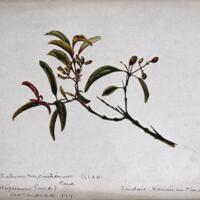Sandalwood
Dublin Core
Title
Subject
Description
Source
Fol. 15v - "Tablets"
Some are made from boxwood inlaid with ebony, sandalwood, ivory, or gold and silver like damascening. Then one writes on it with silverpoint, and next erases it with a cuttlefish bone by rubbing them.
Contributor
Alan Davidson and Tom Jaine, eds., “Sandalwood,” Oxford Reference (Oxford University Press, 2014), https://www.oxfordreference.com/view/10.1093/acref/9780192806819.001.0001/acref-9780192806819-e-2129?rskey=j1yQNk&result=2.
A. N. Arun Kumar, Greta Joshi, and H. Y. Mohan Ram, “Sandalwood: History, Uses, Present Status and the Future,” Current Science (Current Science Association, December 25, 2012), https://www.jstor.org/stable/24089347.
“Sandalwood” World Encyclopedia, (Philip's, 2014), https://www.oxfordreference.com/view/10.1093/acref/9780199546091.001.0001/acref-9780199546091-e-10230?rskey=WB8QDj&result=3.
Sahar Bostock, “Tablets,” in Secrets of Craft and Nature in Renaissance France. A Digital Critical Edition and English Translation of BnF Ms. Fr. 640, ed. Making and Knowing Project, Pamela H. Smith, Naomi Rosenkranz, Tianna Helena Uchacz, Tillmann Taape, Clément Godbarge, Sophie Pitman, Jenny Boulboullé, Joel Klein, Donna Bilak, Marc Smith, and Terry Catapano (New York: Making and Knowing Project, 2020), https://edition640.makingandknowing.org/#/essays/ann_068_fa_18. DOI: https://www.doi.org/10.7916/8ev4-pf02.
Image: Francis Sinclair (after I. Sinclair), “Sandalwood (Santalum album): flowering and fruiting stem,” c. 1887. Chromolithograph. Wellcome Collection, Wellcome Library no. 25343i. https://wellcomecollection.org/works/y3fwava7.
Elia Zhang, Columbia University
